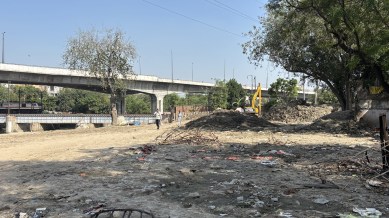Stay updated with the latest - Click here to follow us on Instagram
‘They have moved us from a drain to the gutter’: Madrasi Camp families say they can’t live in Narela
Residents of demolished Jangpura slum continue to rent places nearby, say no schools, facilities, or work in NW Delhi neighbourhood.

63-year-old Ayyama is lying on a mat on the floor of her home, a rented room on the fourth floor in South Delhi’s Ashram, in which she stays with three members of her family.
Ayyama’s husband and other members of her family are away at work. She can’t go to work herself – because, she says, she has bad knees and finds it difficult to climb up and down so many stairs.
monthly limit of free stories.
with an Express account.
A little more than four months ago, Ayyama used to live in Madrasi Camp, an unauthorised cluster of about 370 shanties by the side of the Barapullah drain in Jangpura, not far from Nizamuddin railway station. She worked as a domestic help in several kothis (bungalows) in nearby neighbourhoods.
On June 1, the Delhi Development Authority (DDA) sent in bulldozers to raze the camp, following an order passed by the Delhi High Court the previous month, which noted that the slum cluster was obstructing and clogging the drain, leading to waterlogging, especially during the monsoon.
“None of the dwellers can claim any rights beyond the right of rehabilitation, as the land is public land which is encroached upon,” the court said.
Around 215 families in the erstwhile camp were given flats in Narela in northwest Delhi. But this was almost 50 km from where they lived and worked, and their children went to school – so most of these families either never moved to Narela or came back after finding it difficult to stay there.
Like Ayyama, these families rented places to stay in nearby neighbourhoods such as Ashram, Sarai Kale Khan, and Bhogal.
“Aana jaana bahut mushkil hai (It is very difficult to commute to and from Narela). We go to Narela once a week to our flat, but it takes an entire day to go there and come back. An autorickshaw ride costs Rs 500 each way, but I have no choice – I can’t keep changing buses,” Ayyama said.
For the family, the tradeoff is between paying a high rent and losing livelihoods. “We pay a rent of Rs 9,000 here but we cannot move because my husband, my grandson, and his wife all have their jobs here,” Ayyama said. Her grandson is employed at a call centre in the area, she said.
Madrasi Camp or Madrasi Basti started to come up more than six decades ago as an enclave of Tamil-speaking migrants who came to Delhi looking for work as domestic helps, cooks, and daily-wage labourers. Over time, the Camp evolved into a tightly-knit community of working-class migrants who succeeded in keeping aspects of their culture alive in the city. They also kept their roots close, many of them going back to Tamil Nadu to vote in state elections.
As the demolition began, the government in Chennai issued a statement “reaffirming its unwavering commitment to the welfare of persons of Tamil Nadu origin residing outside the state”, and promising “every possible support” to the residents of Madrasi Camp.
A few lanes away from Ayyama lives Govindhammal (39), with her husband and their three grown-up children. She too pays a rent of Rs 9,000 for a 1BHK flat. She too says going to Narela is currently not an option.
“Woh bahut khatarnaak jagah hai, school nahin hai, paani theek nahin hai, bus bhi nahin hai, aur roz choriyan hoti hain (That is a dangerous place, there is no school, the water is not good, there are no buses, and homes are frequently burgled). How can we stay there?” she said.
Govindhammal works as a cook and help in nearby houses. Her son is in his first year at college, and her two daughters are in Class 11 and 12 at the Delhi Tamil Education Association Sr. Sec. School in Lodhi Estate. One of the girls wants to go to the National Defence Academy (NDA); the other wants to study for a B.Sc.
“There is no work there (in Narela); here we have work, and our children receive education. Earlier, education was not needed, but that time is gone. I am unlettered, but I don’t want my children to be like me,” Govindhammal said.
Like Ayyama, she too has heard about crime in Narela. “There are incidents of theft, and I can’t leave my daughters alone at home,” she said.
Murugesan (70), who sells fruit from a cart near the demolition site in Jangpura, said it is difficult to live in the DDA flat allotted to him. “There is no connection for drinking water, and the sewage backflows and fills the room. How can we live there?” he said.
Said Viruppam, another former resident of Madrasi Camp, “They have moved us from a drain to make us live in the gutter.”
The DDA did not respond to repeated requests seeking a comment on the state of the Narela flats.
Murugesan claimed they had been promised there would be a bus service for them to commute to their place of work, and that a school would be built there.
“But there has been no progress yet. I have heard that students who would come from Narela would sleep in class, because for an 8 am class, they would have to leave by 5.30 or 6 in the morning to reach school,” Murugesan said.